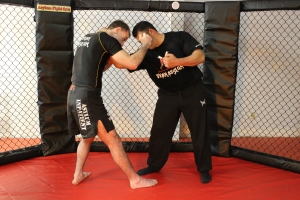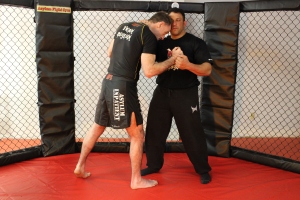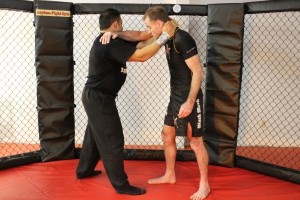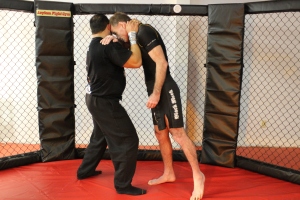Recently conducted a rather lengthy interview with legendary grappling master Gene LeBell for Fightline.com which I’m reposting in its entirety below:
“Judo” Gene LeBell is one of the true legends in the martial arts. Literally born into the fight game, his mother, Aileen Eaton, was the main promoter of boxing and wrestling in Los Angeles from the 1940s through the 1970s. LeBell grew up around the best wrestlers and boxers of his era, receiving his first lesson at age 6 from former world wrestling champion Ed “Strangler” Lewis. He eventually added judo to his repertoire, becoming a two-time national champion in the 1950s before going on to a career as a pro wrestler. He also engaged in what might be considered the first ever televised mixed martial arts contest in 1963, choking out boxer Milo Savage in a judo vs. boxing match. A movie stuntman for more than fifty years, he has possibly appeared on screen more than anyone in history. As a coach, he was worked with former UFC contenders Karo Parisyan and Manny Gamburyan and current women’s champion, Ronda Rousey. He recently sat down for a one on one interview about his career, MMA, Rousey and why he loves being a sadistic bastard.
MJ: So who were some of your main teachers and what can you tell us about them?
GL: There were a lot of them. Lou Thesz, Karl Gotch and Vic Christy all taught me a lot about grappling. When I was training, there were 8 or 10 real shooters (serious catch wrestlers) in the Los Angeles area and when someone wanted to get into that group, they’d beat the crap out of guy and if he came back they knew he was serious and he could work out with them. If he didn’t come back, he wasn’t good enough anyway. I started with these guys when I was a little kid. Christy was one of best of them, though you don’t hear too much about him. I learned a lot of finishing holds from him, arm locks, leg locks back locks, neck locks. From Thesz I learned how to hurt people. He had a little bit of a sadistic side. So did Gotch. Karl told me I’d never be a champion till I learned to be a sadistic bastard. And Larry Coughran was my first judo teacher. He had a judo school and I started there when I was 13. I also trained at the LA Athletic club. But it wasn’t the kind of competition judo you see today where they only allow you a few seconds on the ground.
MJ: You talk quite a bit about having a sadistic side as a fighter. Why is that so important?
GL: If you fight for a living you can’t give a damn about the opponent because they’re trying to take food out of your mouth and your kids’ mouths. Thesz told me life is grappling. You’re in competition with everybody. I tell my grandson if you get an A in school and someone else gets a D, he’s going to be a waiter and you’re going to own the restaurant. The trick is, just don’t let them know you’re competing against them.
MJ: You hear a lot among catch wrestling enthusiasts about Karl Gotch. Some of them say he was the best grappler ever.
GL: Well I won’t argue with them. He showed me a lot of stuff. I saw him get hold of Olympic wrestlers and just gobble them up with front facelocks, choke them out, or break an ankle. He said if a guy gets you in the guard position (what Gotch called foot and leg control) and you can’t break his leg, you should quit wrestling. That’s why I’ve always liked to work a lot of leg locks.
MJ: Then why is it we don’t see more leg locks in mixed martial arts competitions?
GL: Eventually we will see more of it. But really, you have to be able to do everything. When they started the UFC, that Gracie kid (Royce) was a great grappler but he eventually learned you have to work on other stuff like boxing and standing takedowns. When he went against Matt Hughes, Hughes hurt him with punches because he was a better boxer. I’m not knocking anybody – Gracie was the best of his time and Hughes was the best of his time. The same way Thesz and Gotch were the best of their times. But to me, if an Olympic champion was like an 8, Karl was a 10.
MJ: I saw in an interview, Gotch said when he worked with you, he worked on getting you to wrestle without the gi.
GL: It was a learning process for me. I started out doing wrestling but also did a lot of judo where you could choke a guy with your belt – which is technically illegal but who cares – or his collar and that’s a real advantage. So I ended up getting good with the gi and without. Now, in mixed martial arts, they say “rear naked choke.” I was the one who started calling it a rear naked choke in a judo book I wrote back in 1953 to explain the difference between using a gi and no gi, but no one remembers that. They used to just say “choke” before that.
MJ- You fought a boxer named Milo Savage in a judo vs. boxing match. How common were those kind of mixed bouts back then?
GL: Not very common. This was in 1963 and it was the first televised mixed bout ever to my knowledge. Milo was rated number 5 in the world as a boxer. He was really a great fighter. We tried to promote the fight in Los Angeles but the athletic commission wouldn’t allow it because they said it was a duel not a sporting event.
MJ: You trained in catch wrestling, judo and boxing. How common was cross training in different styles back then? Did you see many boxers that learned some wrestling or wrestlers learning some judo?
GL: When guys would get together, sometimes they would exchange information. A few other wrestlers tried judo but most judo guys couldn’t take the wrestling because they got slammed too hard. Someone would pick them up for a double leg, drive them into the ground and bust their shoulder. That was the way Gotch used to do it. I got kicked out of a lot of gyms because if I was at a judo school, I’d tackle them or slap them a little “accidentally.” Or in a boxing gym, if a guy started beating me too bad, I’d suplex him. The only guys really doing cross training back then were a few of the wrestlers. Now MMA has made it profitable to cross train. When you see a karate school nowadays, it says karate and MMA or you see a judo school that has a cage to train in. But who knows how good the teachers are. But my philosophy has always been it’s good to learn everything.
MJ: What was your secret for blending all those styles together?
GL: Everything I did was practical. You have to strip things down and get to the practical stuff.
MJ: How do you compare the level of fighters/martial artists in general from that era to this? Are they better all around fighters nowadays?
GL: There are more good fighters now because of MMA. Also, you never heard of women getting tough before but now there are a lot of really good women who can beat the crap out of some of the men.
MJ: What would you say today’s fighters could learn from the way the old-timers trained?
GL: How to be a sadistic bastard and also how to practice things over and over. Look around at the gym and out of 30 people maybe there are 3 or 4 that are doing a technique over and over. When I teach a group of students, as soon as they practice one hold, most are looking to learn a new one. People think they can take a pill and become a champion. But the harder you work, the luckier you get. You have to work a move hundreds or thousands of times. People don’t do that anymore. When I trained, we’d work out for 6 hours straight, my partner and I would do a hold 100 times back and forth. We’d also work a lot blindfolded so we’d learn to go by feel and know what part of the body we’re going to squash.
MJ: What did you think of the UFC when it first came along?
GL: I loved it. It gave a combination of all the martial arts which is what I always liked to do. If I get you in a leg lock, it’s not legal in judo but it works so who cares? I didn’t like it when they brought more rules in – if I can use your hair or your jamoke as a handle, hey it may not be acceptable but it works – but overall the rules against hitting to the groin or eyes have been a good thing for the sport.
MJ: What’s your opinion of how it’s changed?
GL: There’s more variety now. I think it’s changed for the good. Dana White has really done a great job. He is a hero of mine because he did something I couldn’t do, he made MMA fighting profitable. And a lot of fighters are now earning enough money where they can make a living, buy a house, buy a car because of him.
MJ: It sounds like you’re kissing up to Dana?
GL: Absolutely.
MJ: Who are the best MMA fighters you’ve seen and what do you like about them?
GL: Well of course my favorite is Ronda (Rousey).And I liked Randy Couture because he was a champion wrestler but got to where he could fight on his feet quiet well also. “Bones” Jones is great. He’s very talented. He can punch, kick, wrestle. He does it all. But there are a lot of good fighters, too many to name.
MJ: A lot of people feel Jon Jones is unbeatable right now. How long do you think he can last as champion? Five years? Ten years?
GL: I don’t see anyone being champion for 10 years. There’s always some guy, maybe not as good as you, but he has a good night and you have a bad night and he puts you in retirement.
MJ: You judge MMA matches in California. What do you think of the quality of officiating throughout the sport?
GL: I’ve been a fighter, a referee and a judge but I’m not in charge of hiring officials, it’s not my business. But I think there are a lot of people around the country who shouldn’t be working as officials. You get people who are just fans but they know someone in power and become judges.
MJ: What can be done to improve MMA officiating?
GL: Well, the new head of the California Athletic Commission, Andy Foster, is taking the right steps. He’s the best commissioner I’ve ever seen. In other places people might get their job because they know someone but not with Foster. And a lot of people that used to officiate in California aren’t working anymore because he wants the best. He’s made a lot of the officials here go to John McCarthy, who’s as good a ref as there is, and sign up for his course and they’ve improved. They have to actually learn the sport. A lot of judges maybe have just done boxing or wrestling or muay thai but they don’t know about the other stuff. They don’t really know how much pressure it is on a neck crank or how much a jab can hurt you. If they know some of this stuff, it will make them better officials.
MJ: Let’s talk about Ronda Rousey. Did you coach her mother?
GL: I never coached her mother but was close to her. We’d always see each other at different tournaments and became good friends. Ann Maria was a great champion. She beat everyone back then. She still teaches as a guest instructor at our school occasionally.
MJ: Did you work with Ronda when she was younger?
GL: I worked with her a little bit when she was small. Her mother would come to work out sometimes and Ronda would be there but she was little so it was more like playing games. Then, after she won the bronze medal in the Olympics, I told her she’d win a gold in the next one but she said there’s no money in it. So I introduced her to Darin Harvey, a fight manager who trained with us at my student Gokor’s school (Hayastan MMA), and Darin became her manager.
MJ: What did you tell her about going into MMA?
GL: I just told her three words: “Break an arm.” She’s had 10 matches – 3 amateur and 7 pro – all ended in the first round with an armbar. And she’s busted a few. She has a nice sadistic attitude which is good.
MJ: She sometimes gets criticized for her attitude in interviews but you say she’s a very different person in private.
GL: In pro wrestling, they call the bad guy “a heel” but he’s the one people come to see. Ronda is a heel sometimes, she’ll insult opponents in interviews, so fans don’t always know how nice she really is. But outside the cage she’s a sweetheart.
MJ: What are her strengths and what does she still need to work on?
GL: She does everything. Her boxing is very good now, her wrestling has always been very good. Her judo is good. But now there are a lot of other women who are also very good. Two people will race and one will win by a yard every time. They just have a will to win and they work harder. That’s her big strength.
MJ: What do you think of her upcoming fight with Miesha Tate?
GL: I Just hope it draws money. I want everyone to make money win or lose. It will be tough. This gal, Miesha Tate, is very good.
MJ: Ronda beat her pretty convincingly the first time.
GL: The gal is tough though, she didn’t want to give up when Ronda armbarred her. Miesha said “I’m double jointed.” Well now she’s triple jointed. Ronda is a little sadistic in the cage. She had one match where the other girl was tapping and the referee didn’t stop it. So Ronda rolled her over and broke her arm, which is the right thing to do. There are only two people who can stop a fight, the doctor and the referee. And if the referee doesn’t know what they’re doing, there’s trouble.
MJ: We often see you in Ronda’s corner for fights. What advice do you give her?
GL: I’m in her corner but what I say is a secret. Look, now that she’s a champion, everyone says “I taught her this and I taught her that.” Well her mother taught her that armbar when she was 6. I’m not taking credit for her work, she trains with a lot of good teachers. Let everyone else say it’s them. Meanwhile, Ronda insists I’m in her corner and there’s a reason for it.
MJ: She’s recently begun doing movies. As someone who’s worked in a lot of films, do you think she’ll excel at it?
GL: She’s doing The Expendables 3 and some other stuff. It takes years to be a good actor but her interviews on camera are always great and she’s got a lot of personality.
MJ: Are you worried it will interfere with her training? In general, is it a good idea for fighters to try an acting career while they’re still in the middle of their fight careers?
GL: I think everyone should have five fingers. If three of them get shot off, you still can still pick up your food with the other two. If your MMA or boxing goes down drain, you better have something to keep the wolf away from the door. Ronda was a bartender before she became a successful fighter. What are you going to do, go back to bartending? If she can make it as an actress that’s a good career to have.
MJ: So what’s in the future for Gene LeBell?
GL: I just became partners with Trebla Sports to make a line of martial arts and MMA gear I’m endorsing that includes pads, gis, all sorts of stuff. But I’m 81 years old, I just want to retire and race motorcycles. Motorcycles are like sex to me and I’m not too old for sex.
For more information on Gene LeBell, visit his website, genelebell.com and to order his line of martial arts equipment, visit treblasports.com
Tags: Boxing, Martial Arts, MMA, Sports






























